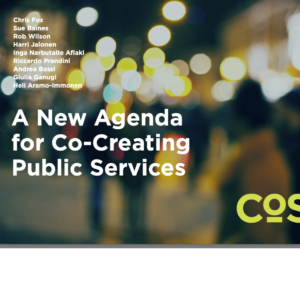CoSIE was informed by learning from research undertaken in Innovative Social Investment; Strengthening Communities in Europe (InnoSI) led by PERU (2015- 2017). A key InnoSI project output is the edited collection Implementing Innovative Social Investment Strategic Lessons from Europe
What is co-creation?
The consortium adopted a definition of co-creation as “a collaborative activity that reduces power imbalances and aims to enrich and enhance the value in public service offerings”.
What was the need?
Established solutions often fail to address contemporary social needs. There is widespread agreement that innovation is needed in public services but little consensus how to achieve it.
What were we doing?
CoSIE took a step forward from InnoSI by co-designing, enacting and evaluating ten real-life pilots to test and develop diverse methods of co-creation.
Sue Baines led the largest CoSIE work package ‘Applied co-creation in pilots’ in partnership with the University of Bologna. The pilots took place in nine countries and various services (including health, social care, employment support and criminal justice). They responded to locally determined social needs and priorities. The UK pilot was ‘Personalised services for people with convictions ’
The focus of CoSIE was on human dimensions but the consortium also searched for new ways to use digital resources to enable co-creation in public services. Cross-cutting work packages including Community Reporting and Living Labs helped to maximise learning and impact.
What are the results / outcomes?
- The CoSIE pilots demonstrate that it is possible to value the lived experience of people who receive public services and nurture their contributions to shaping the services that affect them. This can happen even in contexts that look highly unpromising such as criminal justice.
- Innovative highlights of individual pilots include: new cross-sector collaboration in prevention and treatment of childhood obesity (Italy); strengthened local community integration (Hungary); mobilising people from diverse backgrounds – including vulnerable individuals – around co-defined community problems (Estonia); and nationwide uptake of tools co-designed by young people for youth workers (Finland).
- A legacy of CoSIE is ensured by cross-cutting actions especially in the form of responsibly curated digital storytelling mobilised for change, and the COSMOS tool developed from Living Lab technology within the project to scaffold co-creation by building and sharing visual models.
- Some CoSIE pilots have managed to get beyond local implementation and begun to make a difference on a larger scale. Common factors that distinguish them appear to be energetic and proactive networking, enrolling the interest of stakeholders with power to act, and meeting perceived needs of other agencies in other places
Project downloads
Read more about CoSIE in our three ‘positioning papers’:



Reusable learning from CoSIE (tested in a new pilot site) is encapsulated in a MOOC and the accessible, interactive CoSIE Roadmap. You can also access the project website here.
Disclaimer: This project has received funding from the European Union’s Horizon 2020 research and innovation programme under grant agreement No 770492. The content of the website reflects the authors’ views and the Managing Agency cannot be held responsible for any use that may be made of the information it contains.
Who are we working with?
In Estonia: Helpific Tallinn University Vorumaa Local Governments Association
In Finland: Association of Finnish Local and Regional Authorities Turku University of Applied Sciences
In Greece: Panteion University of Social and Political Sciences
In Hungary: University of Debrecen ESÉLY (Chance) Social Public Foundation of Jász-Nagykun-Szolnok County
In Italy: University of Bologna Local Health Authority in the Province of Reggio Emilia CUP 2000 Ltd.
In The Netherlands: Houten municipality Nieuwegein municipality HU University of Applied Sciences Utrecht
In Poland: Active Senior Foundation University of Wroclaw
In Spain: Foundation for Employment in the City of Valencia Polytechnic University of Valencia
In Sweden: Jönköping municipality Karlstad University
In the UK: Interserve Investments Limited People’s Voice Media LBG University of Northumbria
Project Timescale
This project finished in 2021, but outputs are still being produced.
PERU Projects
Nothing found.